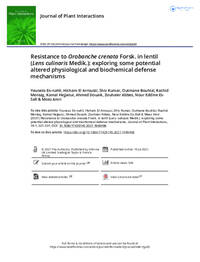Resistance to Orobanche crenata Forsk. in lentil (Lens culinaris Medik.): exploring some potential altered physiological and biochemical defense mechanisms

Authors:
Management of broomrape (Orobanche crenata Fosk.) that causes important damages on lentil production becomes a veritable concern in the Mediterranean region. Eighty lentil accessions were evaluated for resistance to O. crenata under field and controlled conditions. Both genotypes ILL6415 and ILL7723 expressed the highest resistance level under field and pot experiment with low Orobanche infestation and relatively high seed yield (50.1 g m−2). Such resistance was associated with physiological and biochemical changes in metabolites profiling. In total, 109 and 115 metabolites were identified in the lipophilic phase of both ILL6415 and ILL7723, respectively, against only 92 metabolites recorded for susceptible check Zaaria. Significant differences were observed in metabolite concentrations (fatty acids, sterols alkanes) between roots and shoots of susceptible and resistant infested plants. Accumulation of α-linolenic acid and arachidic acid was more pronounced in the resistant genotypes ILL6415, ILL7723 which could be associated with resistance pathways involved in the resistance to O. crenata.
